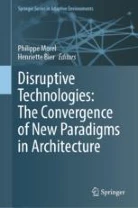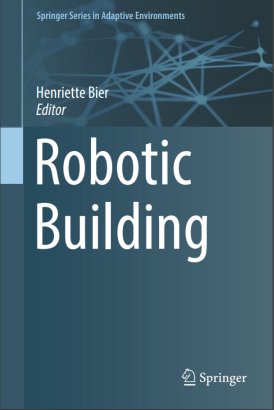BOOKS
Disruptive Technologies: The Convergence of New Paradigms in Architecture
Editors: Philippe Morel, Henriette Bier
Series: Springer Series in Adaptive Environments
- Presents hypotheses and arguments about the influence of technologies on architecture and urban design
- Includes some of the most acclaimed voices in architectural theory, education, and practice
- Brings essential references to students, scholars and practitioners, interested in built environment
Through a series of highly speculative contributions by both leading and highly acclaimed practitioners and theorists, this book gives a new comprehensive overview of architectures’ most recent practical and theoretical developments.
While a few chapters are mostly dedicated to a historical analysis of how we got to experience a new technological reality in architecture and beyond, all chapters – including the most forward looking, have in common their rigorous understanding of history as a pool of radical experiments, whether one speaks of the history of architecture, or of sociology, technology, and science.
Disruptive Technologies: The Convergence of New Paradigms in Architecture is required reading for anybody – student, practitioner, and educator – who wants to do serious research in architecture and all disciplines dealing with the shaping of our environment, beyond the important but restricted domain of computational architectural design.
https://link.springer.com/book/9783031141591
Robotic Building
Henriette Bier (Ed.)
Series: Springer Series in Adaptive Environments
- Treats both theoretical and practical aspects of robotics in architecture
- Focuses on design-to-robotic-production and -operation
- Reviews exhaustively the key recent research into robotic systems, reconfigurable structures and architectured materials
The first volume of the Adaptive Environments series focuses on Robotic Building, which refers to both physically built robotic environments and robotically supported building processes. Physically built robotic environments consist of reconfigurable, adaptive systems incorporating sensor-actuator mechanisms that enable buildings to interact with their users and surroundings in real-time. These require Design-to-Production and Operation chains that are numerically controlled and (partially or completely) robotically driven. From architectured materials, on- and off-site robotic production to robotic building operation augmenting everyday life, the volume examines achievements of the last decades and outlines potential future developments in Robotic Building. This book offers an overview of the developments within robotics in architecture so far, and explains the future possibilities of this field. The study of interactions between human and non-human agents at building, design, production and operation level will interest readers seeking information on architecture, design-to-roboticproduction and design-to-robotic-operation.
http://www.springer.com/gp/book/9783319708652
Springer Series in Adaptive Environments
The Springer Series in Adaptive Environments presents cutting-edge research around spatial constructs and systems that are specifically designed to be adaptive to their surroundings and to their inhabitants. The creation and understanding of such adaptive Environments spans the expertise of multiple disciplines, from architecture to design, from materials to urban research, from wearable technologies to robotics, from data mining to machine learning and from sociology to psychology.
The focus is on the interaction between human and non-human agents, with people being both the drivers and the recipients of adaptivity embedded into environments. There is emphasis on design, from the inception to the development and to the operation of adaptive environments, while taking into account that digital technologies underpin the experimental and everyday implementations in this area.
Books in the series will be authored or edited volumes addressing a wide variety of topics related to Adaptive Environments (AEs) including:
- Interaction and inhabitation of adaptive environments
- Design to production and operation of adaptive environments
- Wearable and pervasive sensing
- Data acquisition, data mining, machine learning
- Human-robot collaborative interaction
- User interfaces for adaptive and self-learning environments
- Augmented reality/location-based interaction
- Gamification environments
- Emergent development of buildings/cities
- Environmental explorations
Editors-in-chief
Holger Schnädelbach, The University of Nottingham, United Kingdom
Henriette Bier, Technical University Delft, The Netherlands
Kristof Van Laerhoven, University of Siegen, Germany
Editorial Board
Keith Green, Cornell University, USA
Justin Dirrenberger, CNAM, France
Sebastian Vehlken, Leuphana University, Germany
Jean Vanderdonkt, Université catholique de Louvain, Belgium
Mikael Wiberg, Umeå University, Sweden
Omar Khan, Buffalo University, USA
Marcus Foth, Queensland University of Technology, Australia
Ava Fatah, University College London, United Kingdom
Martin Knöll, Technical University Darmstadt, Germany
Gerd Kortuem, Technical University Delft, Netherlands
Hedda Schmidtke, University of Oregon, USA
Norbert Streitz, Smart Future Initiative, Germany
David Gerber, Arup Research, United Kingdom
https://www.springer.com/series/15693



